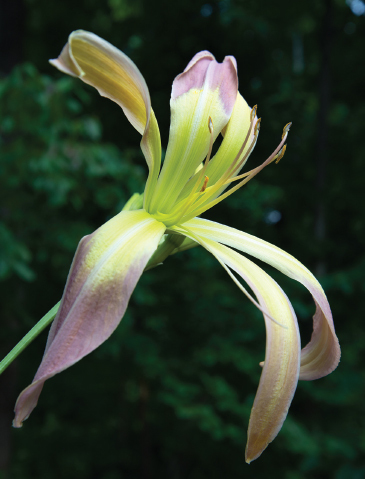EEEK! A SPIDER!
For gardeners afraid of eight-legged creatures in the garden, perhaps it is time to welcome a different kind of spider into the landscape. Many botanical gems have names that include “spider,” a reference to arachnid-like characteristics that have been blended with beauty and charm to create must-have plants for backyard growers — even those scared of real spiders.
Below are four such special — not spooky — plants for your green thumb enjoyment this year:
Spider Daylilies (Hemerocallis sp.)
This is a classification of daylilies defined by the American Hemerocallis Society as a selection having flowers with petals four times the length of their width. And for maximum visual flower power, the longer the length, the better. Exotic, intriguing, inviting — all describe these blooms that reach out their skinny fingers to extend a welcome to the garden. And don’t worry about rarity; there are hundreds of cultivars. Some of my favorites include ‘Tennessee Flycatcher,’ ‘Wilson Spider,’ ‘Jan’s Twister,’ ‘Skin Walker,’ ‘Jungle Princess’ and ‘Radiation Biohazard.’
Spiderwort (Tradescantia sp.)
When cut, the stems of this perennial ooze a liquid that, upon hardening, resembles the threads of a spider’s web. Add “wort,’ an older English word for “plant,” and you have “spiderwort.” You also have a dependable native beauty with 1-inch, three-petal flowers that is a worthy addition to any summer border. Bluish-purple is the typical bloom color, but cultivars have been developed that stretch their spectrum into the pleasing pinks and delicate whites. Spiderworts do best in partially shaded areas, but they can also show off in sunny locations if given extra water, especially in the summer.
Red Spider Lily (Lycoris radiata)
Talk about a strange growing habit — this bulb’s slim leaves emerge in the fall, persist through the winter and die down in the spring, leaving nothing to see. But late in the summer, tall, skinny spikes spring from the baked earth and explode in a dazzling display of rich red, spider-shaped blossoms. Since it is such a late bloomer, red spider lily is an ideal plant to mix into a perennial flowerbed to add eye-pleasing pop in an area where most of the plants have called it quits for the growing season. Expect red spider lilies to stick around — they are tough, drought-tolerant bulbs that will naturalize in area gardens.
Spider Flower (Cleome hassleriana)
Sometimes referred to as simply “cleome,” this fast-growing annual displays large (up to 8 inches in diameter), round, spindly blooms that look like — you guessed it — spiders. Different colored spiders, too — the flowers can sport lavender, pink, rose or white hues. These blossoms are held aloft on sturdy 5- to 6-foot stems, although dwarf cultivars, such as the popular ‘Sparkler,’ restrain their stretch to about 3 feet tall. This sun-worshiping plant is easily grown from seeds, and it also reseeds in the garden. However, keep in mind that spider flowers reseeded from hybrid selections probably won’t be true copies of their parents.
L.A. Jackson is the former editor of Carolina Gardener Magazine. Want to ask L.A. a question about your garden? Contact him by email at lajackson1@gmail.com.
To Do in the Garden: May
It is gladioli planting time! The best location for these bulbs is in a well-drained site protected from the wind. If the rains don’t come, water weekly after the spikes pop out of the ground. Heat-seeking cannas, caladiums and dahlias can also be planted now.
If you want stronger, bushier plants with more flowers, prepare to give them a pinch. Pinching back the tips encourages branching and more compact growth. This is especially true for such popular ornamentals as petunias, annual salvias and zinnias. The herb basil also benefits from being pinched back.
Have a constant need to feed your plants? Add nutrients at a controlled, safe rate by watering with compost tea or diluted fish emulsion once a month.
If your azaleas, gardenias, hydrangeas, magnolias or rhododendrons have begun to look sickly with yellow leaves streaked by green veins, it could be a sign of iron chlorosis. This disorder can be easily cured with a light application of Epsom salt around the base of the afflicted plant.
With the heat beginning to build, the season of cool-season vegetables such as broccoli, collards, lettuce, spinach and kale is ending. Begin removing spent and bolting plants to provide more room for summer veggies.
If you haven’t already started, it is time to get those summer vegetables in the ground! Fill your edible garden with such delectable delights as tomatoes, beans, peppers, okra, squash, cucumbers, eggplants and watermelons.
Want sweet rather than bitter cucumbers? Mulch the plants and put them on a regular watering schedule. Also, cukes don’t store well on the vine, so pick early and pick often.
The temperature has warmed up enough to bring houseplants out for a summer vacation. Just be sure to locate them in areas that receive filtered shade most of the day to prevent sunscald.
Timely Tip
Thinking about building a raised garden but are concerned about the chemicals used in pressure-treated lumber leeching into the soil?
About 10 years ago, wood treated with Chromated Copper Arsenate (CCA), which included the toxin arsenic, was replaced with a safer, copper-based compound.
However, if you still would rather not have any commercial preservatives seeping into the soil of your raised garden, simply cover the inside walls of the wood barrier with a rubber or plastic liner. Better yet, use a wood such as cypress or cedar, which while more expensive, is naturally resistant to decay and will last for years.
Also, for an even more permanent enclosure that blends in nicely with natural surroundings, consider dry-stack stone walls.








